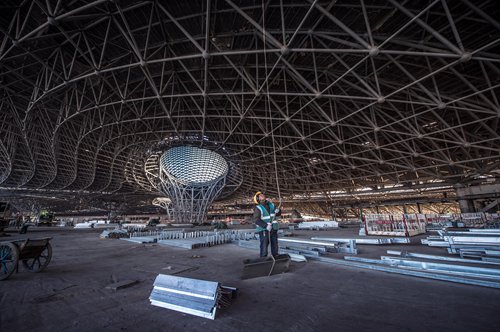
A worker labors at the construction site of the main terminal for the new airport in Daxing district, Beijing. Photo: IC
Seven years after its establishment, a subsidiary company under Air China has once again come under the spotlight.
A note posted on the website of the Civil Aviation Administration of China (CAAC) on Tuesday showed that Beijing Airlines, which previously focused on the business jet, now plans to expand to civil transportation.
The move shows not only that Air China is reminding the industry of its right of way in Beijing, a market that is becoming ever fiercer with the arrival of more competitors, but also Air China's big ambitions in the new airport being built in the capital's southern Daxing district.
According to the note, Beijing Airlines has a registered capital of 1 billion yuan ($158.1 million), with 510 million yuan of that coming from Air China.
As part of its new business venture, the carrier plans to adopt B737-800 aircraft, and Air China will be in charge of its slots, flights and staff.
Fierce competition
For many years, Air China has been the biggest carrier in Beijing in terms of market share, but recently, its major rivals - Hainan Airlines, China Southern Airlines and China Eastern Airlines - have been tapping further into the capital's market, posing harsh competition for the Beijing-based airline giant.
For example, in 2005, China Southern set up its Beijing branch, and so far, the carrier has inputted about 70 fleets, including a fleet of 5 jumbo jet A380s. On top of that, the Guangdong-based airline has opened more than 50 domestic and international routes departing from Beijing.
A survey conducted in October 2017 by the big data institute under VariFlight, a Chinese aviation data provider, showed that the transport capacity of Air China in Beijing Capital International Airport (BCIA) accounted for 38 percent of the total at that time, while China Southern and China Eastern accounted for 12 and 11 percent, respectively.
With the help of BCIA, Air China has become the largest Chinese carrier in the markets to and from Europe and to and from the US.
However, as slots in BCIA are always in hot demand, leaving more and more carriers scrambling to enter the Beijing market, the new airport under construction in Daxing has provided some hope for those players desperate to expand to the capital.
Fresh opportunities
The new airport has an investment of 79.98 billion yuan and is scheduled to be completed in 2019. Its location is 46 kilometers south of Tiananmen Square in downtown Beijing and a direct distance of 70 kilometers from BCIA, with the annual passenger flow expected to reach 100 million by 2040.
According to earlier plans made by the CAAC, China Eastern and China Southern will be moved to the new airport, a relocation that could take up to four years, while Star Alliance members such as Air China will stay at BCIA.
Both China Eastern and China Southern have set their construction targets so that they are able to shoulder 40 percent each of the passenger flow at the new airport.
In 2017, China Southern unveiled that it plans to put 250 aircraft in the new airport by 2025 as part of its aim to build twin hubs in Guangzhou, capital of South China's Guangdong Province, as well as in Beijing.
Meanwhile, China Eastern said it will input 150 to 250 aircraft in the new airport, and build twin hubs in Beijing and Shanghai.
Also, budget carriers such as Spring Airlines have signed relocation agreements and thus plan to move to the new airport along with those giants.
It is clear that the new airport must serve not only the capital as a whole, but also the Xiongan New Area, a rising star about 100 kilometers south of the capital.
Although Air China will stay at BCIA, the carrier does not want to miss any chances at the new airport.
As such, its subsidiary Beijing Airlines is expected to grab those opportunities, as the new airport and BCIA morph into the twin hubs of the aviation industry in Beijing.
Nevertheless, we should take note of the fact that, according to the CAAC's website post, Beijing Airlines has actually applied for a base at BCIA as part of its new venture. Its fate at the new airport therefore will remain a mystery until the airport's opening in 2019.

